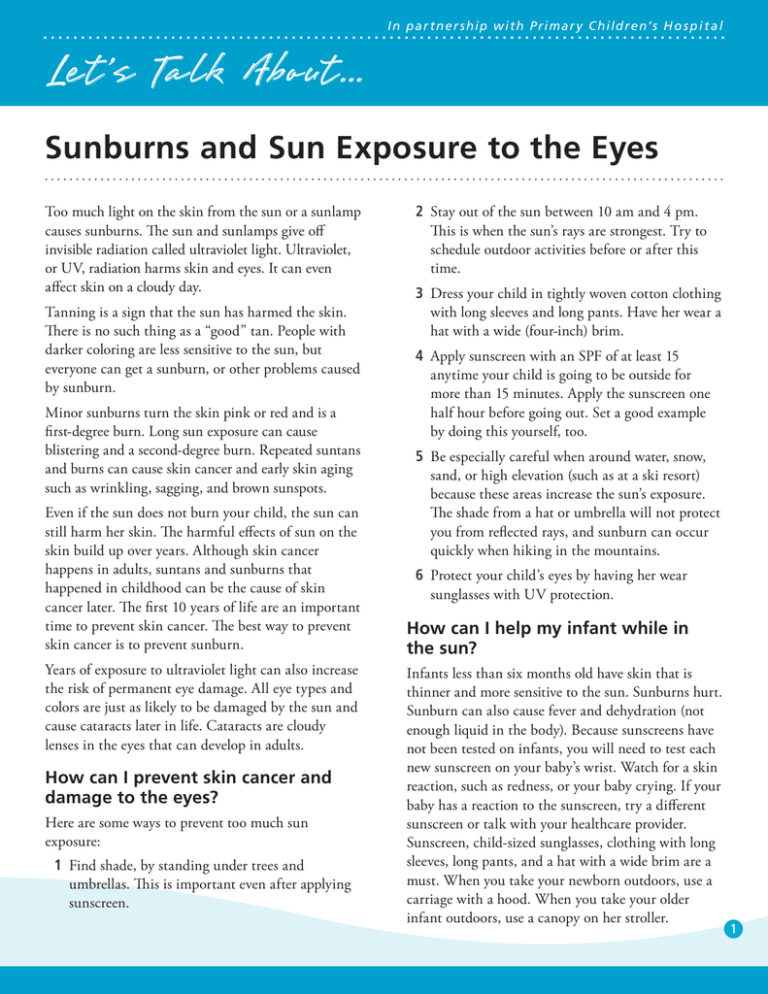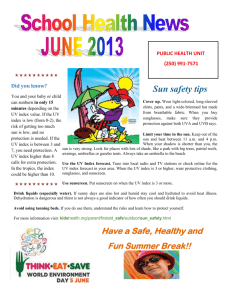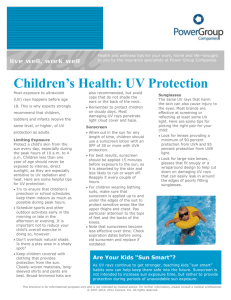
I n p ar t n e r ship w i t h P r imar y Child r e n’s H o s p i t a l
Let ’s Talk About...
Sunburns and Sun Exposure to the Eyes
Too much light on the skin from the sun or a sunlamp
causes sunburns. The sun and sunlamps give off
invisible radiation called ultraviolet light. Ultraviolet,
or UV, radiation harms skin and eyes. It can even
affect skin on a cloudy day.
Tanning is a sign that the sun has harmed the skin.
There is no such thing as a “good” tan. People with
darker coloring are less sensitive to the sun, but
everyone can get a sunburn, or other problems caused
by sunburn.
Minor sunburns turn the skin pink or red and is a
first-degree burn. Long sun exposure can cause
blistering and a second-degree burn. Repeated suntans
and burns can cause skin cancer and early skin aging
such as wrinkling, sagging, and brown sunspots.
Even if the sun does not burn your child, the sun can
still harm her skin. The harmful effects of sun on the
skin build up over years. Although skin cancer
happens in adults, suntans and sunburns that
happened in childhood can be the cause of skin
cancer later. The first 10 years of life are an important
time to prevent skin cancer. The best way to prevent
skin cancer is to prevent sunburn.
Years of exposure to ultraviolet light can also increase
the risk of permanent eye damage. All eye types and
colors are just as likely to be damaged by the sun and
cause cataracts later in life. Cataracts are cloudy
lenses in the eyes that can develop in adults.
How can I prevent skin cancer and
damage to the eyes?
Here are some ways to prevent too much sun
exposure:
1 Find shade, by standing under trees and
umbrellas. This is important even after applying
sunscreen.
2 Stay out of the sun between 10 am and 4 pm.
This is when the sun’s rays are strongest. Try to
schedule outdoor activities before or after this
time.
3 Dress your child in tightly woven cotton clothing
with long sleeves and long pants. Have her wear a
hat with a wide (four-inch) brim.
4 Apply sunscreen with an SPF of at least 15
anytime your child is going to be outside for
more than 15 minutes. Apply the sunscreen one
half hour before going out. Set a good example
by doing this yourself, too.
5 Be especially careful when around water, snow,
sand, or high elevation (such as at a ski resort)
because these areas increase the sun’s exposure.
The shade from a hat or umbrella will not protect
you from reflected rays, and sunburn can occur
quickly when hiking in the mountains.
6 Protect your child’s eyes by having her wear
sunglasses with UV protection.
How can I help my infant while in
the sun?
Infants less than six months old have skin that is
thinner and more sensitive to the sun. Sunburns hurt.
Sunburn can also cause fever and dehydration (not
enough liquid in the body). Because sunscreens have
not been tested on infants, you will need to test each
new sunscreen on your baby’s wrist. Watch for a skin
reaction, such as redness, or your baby crying. If your
baby has a reaction to the sunscreen, try a different
sunscreen or talk with your healthcare provider.
Sunscreen, child-sized sunglasses, clothing with long
sleeves, long pants, and a hat with a wide brim are a
must. When you take your newborn outdoors, use a
carriage with a hood. When you take your older
infant outdoors, use a canopy on her stroller.
1
What kind of sunscreen should I use
with my child?
Suntan lotion is not sunscreen. Sunscreen has a Sun
Protection Factor (SPF) that filters the amount of sun
that gets through to the skin. In the intermountain
area, you should use a sunscreen that has an SPF of
15 or more. SPF-30 sunscreen is recommended.
Apply sunscreen to your child at least 30 minutes
before she goes outside. This gives the sunscreen time
to get into the skin for protection. Be sure to protect
your child’s nose, lips, ears, cheeks, neck, shoulders,
and even the back of her knees. Reapply sunscreen
every 3–4 hours or earlier if swimming or when
sweating a lot. A “waterproof” sunscreen stays on for
about 30 minutes in water, and then you need to
reapply it. Remember, your child can still get a
sunburn even after applying sunscreen.
burns. They often contain benzocaine, which can
cause an allergic rash, and they do not relieve the
pain of first-degree burns. You can give your child
ibuprofen (Advil® and Motrin®) or acetaminophen
(Tylenol®) to make her more comfortable. Do not
give your child aspirin because of the risk of a serious
disease called Reye syndrome (see note at end of
handout). Peeling usually happens on the fifth to
seventh day.
When should I call my child’s doctor?
Call your child’s doctor if…
•• Your child becomes unable to look at lights because
of eye pain.
•• Your child has a fever over 102° F (38.9°C).
•• The sunburn becomes infected.
What kind of sunglasses should my
child use?
•• Your child starts acting very sick.
Choosing sunglasses is as important as sunscreen.
Choose sunglasses that cover your child’s eyes and
some of the surrounding area. The label should say
the sunglasses block out at least 99% of both UVA
and UVB radiation. They should also meet “ANSI
standards.” If your child is taking medication, talk
with your healthcare provider about possible sun
reactions because of the medication. Sun reactions
can include rash, redness, and swelling.
Note: You can use acetaminophen (Tylenol®) for a
temperature over 101°F (38.3°C). Do not give aspirin
to children with fever-causing illnesses since it can
lead to a brain, liver, and kidney disease called Reye
syndrome. Read the label on all medicines, including
medicines like Alka Seltzer® to make sure they do not
contain small amounts of aspirin. You can give
ibuprofen to children who are six months old and
older, but it should never be given to children who are
dehydrated or vomiting (throwing up) continuously.
How can I help if my child gets
a sunburn?
•• The blisters start to break open.
A sunburn causes pain and heat that may last for 48
hours. You can help your child be more comfortable
by giving her cool baths or compresses several times
a day.
It helps to add 2–3 tablespoons of baking soda to the
tub. Do not use any soap on the sunburn. Do not
apply ointments or butter to the sunburn. These just
make things worse and are painful to remove. Do not
use any of the common first aid creams or sprays for
© 2015 Intermountain Healthcare, Primary Children’s Hospital. All rights reserved. The content presented here is for your
information only. It is not a substitute for professional medical advice, and it should not be used to diagnose or treat a health problem
or disease. Please consult your healthcare provider if you have any questions or concerns. More health information is available at
intermountainhealthcare.org. Pediatric Education Services 801-662-3500 LTA339 - 10/15 Also available in Spanish.
2


